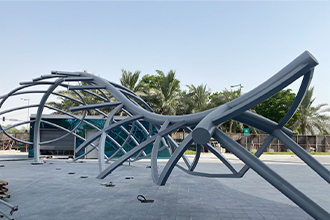
Shaped steel structure
Shaped steel structures are steel structures that are irregular in shape, size, and connection methods, often with complex geometries and structural layouts. Its design may face some unique challenges and difficulties compared to conventional structures. The following are some of the common difficulties in the design of shaped steel structures:
- Complex geometry: Shaped steel structures often have very complex geometries, which may include curves, bends, mitred corners, etc., making the analysis and calculation of the structure more complex.
- Connection design: Connections in shaped structures often require special design to accommodate unconventional geometries. This may require the development of customised connections, which can increase design difficulties and costs.
- Uneven force distribution: Due to the irregularity of shaped structures, forces may be distributed unevenly, requiring complex force analysis and design to ensure structural stability and safety.
- Complex structural analysis: The complex shape of shaped structures makes analysis methods such as finite element analysis more difficult, requiring the use of advanced numerical calculation and simulation tools.
- Low material utilisation: The irregularity of the shape may lead to lower material utilisation, increasing the cost of the structure. Designers need to weigh the stability of the structure against its economy.
- Construction Difficulty: Shaped structures are relatively difficult to construct, requiring customised formwork, bracing and welding processes, which can be more complex.
- Design co-ordination: Shaped structure design often needs to be co-ordinated with other building systems (e.g. M&E, drainage, etc.), which requires greater co-ordination of the overall building design.
- Codes and Standards Constraints: Codes and standards for conventional structural design are usually based on common shapes and structural types, and may lack clarity for shaped structures, requiring designers to design within the constraints of the code.
As a result, designers need in-depth structural engineering knowledge and experience when dealing with shaped steel structures, and may need to utilise advanced computational tools and simulation techniques to ensure that the structure has sufficient strength and stability, yet can be economically designed and constructed.











 About Us
About Us 2023-12-08
2023-12-08


